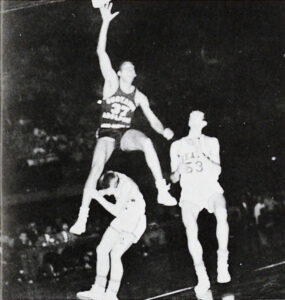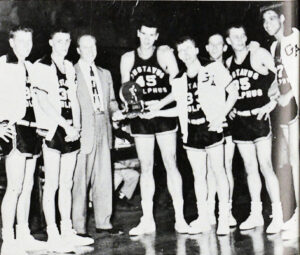The 1950s truly was the golden era of Gustavus men’s basketball. Head Coach Gus Young guided the Gusties to three consecutive runner-up finishes in the MIAC before dethroning Jon Hutton’s Hamline Pipers for conference championships in 1954, 1955, and 1956.
The makeup of those championship teams was extraordinary. The lineup for the 1956 squad that won a third-straight MIAC title and advanced to the quarterfinals of the NAIA tournament included four future Gustavus Athletics Hall of Famers under the direction of a Hall of Fame coach. 1956 graduates Jack Colvard, Jim Springer, John Patzwald, and Bob Erdman all entered the Hall of Fame years after their playing days were over, while Shorty Patterson played as a major contributor.
Coach Young and his squad of future Hall of Famers became the best in the MIAC by playing a tough schedule against larger schools across the country.
“Gus got these games scheduled probably because the bigger schools thought we were competitive enough to beat up on a little bit,” said Bob Erdman. “We were sometimes a little more competitive than they thought we were.”
But travelling to certain parts of the nation during the 1950s presented a much larger challenge than simply competing against bigger schools.

“Anytime we went south, our one black player couldn’t play. We got used to that,” Erdman recalled. “Shorty [Patterson] was probably one of the best ball players that ever played at Gustavus. We called him Shorty but he was about 6-8 and could jump out of the gym. When we got down to Western Kentucky he couldn’t play. I think if we had Shorty we might have beaten them. Without Shorty we were good, but not nearly as good.”
The Gusties were handicapped without Patterson on numerous occasions, most notably against Dayton University, who was ranked No. 2 in the nation in 1956 and has since gone on to have a rich tradition of success at the NCAA Division I level.
“We went to Dayton, Ohio and they were rated number two in the nation when we played them, and Shorty, of course, couldn’t play,” Erdman said. “They beat us by 26 points, and I held their best scorer down to 27 points. That was Paxson I believe.” (Jim Paxson Sr. went on to play professionally for the Minneapolis Lakers and Cincinnati Royals.)
Even some of the hotels the Gusties stayed in while on their road trips would only admit white people, so Erdman was often tasked with finding another hotel with Patterson for both of them to stay.
The adversities Gustavus faced early in the schedule, both on and off the court, set the team up for success later down the road. Coach Young, characterized as an irrepressible sort or person, used many different tactics to get the best out of his players, even if it meant reaching a boiling point with his emotions.
“We loved Gus, he always surprised us,” Erdman said. “We went to North Dakota State and we were behind by 12 points or something at halftime; we were seldom behind another area school other than the University of Minnesota. He threw a basketball, broke a mirror, and left, and we didn’t see him until Monday. We won that ballgame by 17 points. Cliff Straka [’55, also a Hall of Famer] became the coach and player. Gus kind of woke us up but never said a word. We went back and thought, ‘Oh I wonder what Gus is going to say in practice on Monday.’ He never said a word, we never said a word, but he did eventually say ‘I’m glad you won.’”
Coach Young was more than just a coach of the program – he was full of optimism and ideas. Home games at Myrum Memorial Fieldhouse showcased fancy warm-up drills, a tuxedo-suited pep band, halftime variety shows that featured a 100-voice male choir, and spotlighted flag ceremonies. Even the playing surface was unique with a raised floor that offered a generous bounce.
“Everyone on my team could dunk on that floor except John Patzwald and he was 5-10,” Erdman said. “It was a great floor, it was a great atmosphere. I don’t think we ever played without it being a full house. They were all old men who wore old caps and they stood in lines to get into the games because Gus had colored basketballs and we had a male choir singing; it was a show. People within 60 miles made it to every game they could. It couldn’t have been any better for me and most of the guys I played with.”
Gus’ wife, Evelyn, who ran the Gustavus food service for more than three decades, shared a great enthusiasm for Gustie men’s basketball and was perhaps the most vocal fan during games.
“Evelyn always got excited and the other teams’ fans would always dress up somebody that didn’t look anything like Evelyn who was supposed to represent her and her enthusiasm,” Erdman said. “I was dribbling up the court once and Evelyn was right behind me saying, ‘Come on, Bobby, come on, Bobby!’ and I said, ‘Evelyn, I don’t think you should be here.’ So, she went off to the side. But she was something very special to us and to Gustavus. That was a wonderful experience for anyone to play for them [Gus and Evelyn]. We often considered it playing for them.”

Seniors of the 1955-56 team culminated their collegiate careers with a third consecutive MIAC title and three victories in the NAIA national tournament. Jim Springer, a three-time All-Conference center who was known for his ability to score (1,662 career points rank third in program history), used his height to his advantage during that playoff run and still holds the program record for rebounds in a game after hauling in 24 during an 80-60 victory over Eastern Tennessee State in the second round of the NAIA playoffs.
“Rebounding wasn’t Jim’s main concern,” Erdman said. “His main concern was scoring points but he was also big enough to rebound a lot. He would rebound so he could score. The best rebounders we had were Colvard and Shorty. Shorty was known as the ‘Black Cloud,’ he just took over. Colvard, when it came down to it, he was as tough as anybody when we played big schools.”
Along with Erdman at the guard, Patzwald, an All-American, controlled the pace of play with his outstanding dribbling ability.
“Patzwald was way ahead of the game,” Erdman said. “He could dribble around and you could stall forever and he could stall all by himself. But we never really had to do that.”
After beating San Diego State 69-60 in the third round of the 1956 NAIA playoffs, the Gusties eventually lost to Wheaton, ending the careers of the four future Hall of Famers. A team comprised of players mostly from the Twin Cities metro, Coach Young knew he had a special group and recognized them accordingly.
“We went to a lot of banquets because we won enough times to have banquets,” Erdman said. “Gus would always introduce us as ‘Shorty Patterson, All-City, All-State from North; D.L. Smith, All-City, All-State from North; John Patzwald, All-City, All-State from Central; Jim Springer, All-City, All-State from West;’ and Gus would always introduce me as ‘All-Backyard from St. James.’
“He asked me, “You care if I do that, Bob?’
“‘As long as I play, Gus, I don’t care what you call me.’”